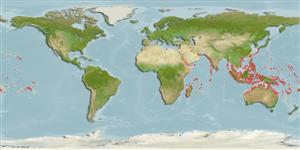Common names from other countries
Environment: milieu / climate zone / depth range / distribution range
Écologie
Récifal; profondeur 0 - 20 m (Ref. 8294). Tropical; 31°N - 32°S, 32°E - 138°W (Ref. 846)
Indo-Pacific. Tropical to subtropical.
Length at first maturity / Taille / Poids / Âge
Maturity: Lm ? range ? - ? cm
Description synthétique
Morphologie
Colonies are composed of thin unifacial laminae sometimes forming tiers or whorls. Corallites are arranged in rows between coenosteum ridges, which are conspicuous and usually perpendicular to colony margins. Cream, pink or brown with pale margins (Ref. 846).
Maximum depth from Ref. 98471. Inhabits mostly protected upper reef slopes (Ref. 846).
Life cycle and mating behavior
Maturité | Reproduction | Frai | Œufs | Fécondité | Larves
Hermaphroditic (Ref. 113712). Mature gametes are shed into the coelenteron and spawned through the mouth. Life cycle: The zygote develops into a planktonic planula larva. Metamorphosis begins with early morphogenesis of tentacles, septa and pharynx before larval settlement on the aboral end (Ref. 833).
Nemenzo, F. Sr. 1986. (Ref. 910)
Statut dans la liste rouge de l'IUCN (Ref. 130435)
statut CITES (Ref. 108899)
Not Evaluated
Utilisations par l'homme
| FishSource |
Outils
Sources Internet
Estimates based on models
Preferred temperature
(Ref.
115969): 25.1 - 29.3, mean 28.4 (based on 3576 cells).
Catégorie de prix
Unknown.
